Enjoy pork belly seasoned with a rich sauce, offering a melt-in-your-mouth texture! Buta no Kakuni is one of Japan's most iconic simmered pork dishes. The sweet and savory sauce penetrates deep into the meat, creating a flavor that is sure to captivate you.
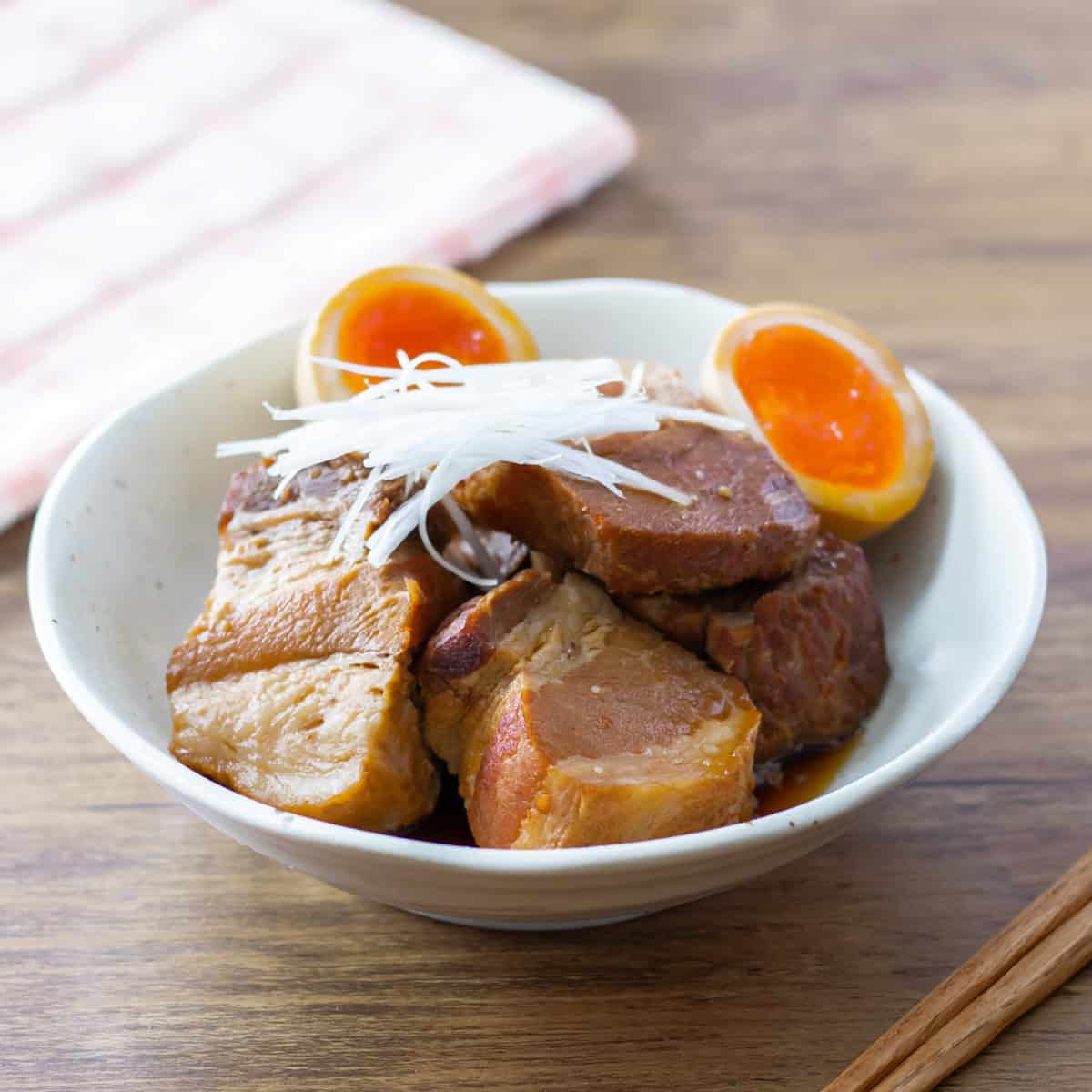
While a simplified version of this dish can be prepared in just a few hours, my recipe takes more time to achieve the authentic flavor and texture that you would expect from a traditional Japanese restaurant. Whether you are making this dish for the first time or have made it before, I highly recommend giving this recipe a try!
Jump to:
What is Buta no Kakuni?
Buta no Kakuni is a Japanese dish made by slowly simmering pork belly with seasonings like sugar and soy sauce, after first simmering it to remove any unpleasant odors. ”Buta” means pork, "no" indicates possession (connecting the preceding and following words), and "Kakuni" refers to a dish in which cubed ingredients are simmered in a seasoned liquid. Pork is the most common ingredient for kakuni, making buta no kakuni one of the most iconic dishes in Japanese cuisine featuring pork.
The key to making this dish delicious lies in properly removing the pork's odors and ensuring the seasonings thoroughly infuse the meat. While the process for achieving this is straightforward, it does require a significant amount of time. However, I guarantee that if you take the time to prepare it carefully, the result will taste just as good as what you would find at a traditional Japanese restaurant. Try making this dish and enjoy the Japanese sweet-savory flavors, with each bite of tender, slow-cooked pork melting in your mouth.
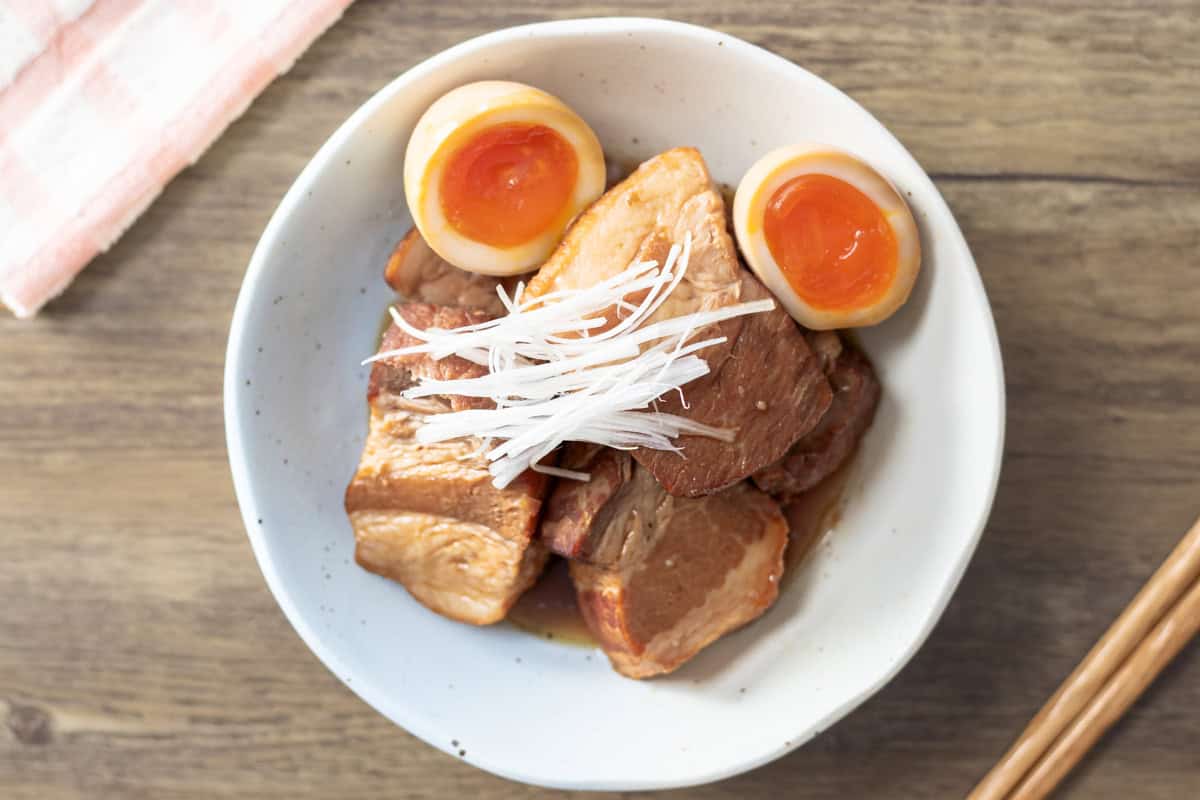
Key cooking processes
The following are the main steps for preparing buta no kakuni. Understanding the role of each step will help you make this dish successfully.
Sear the pork
This dish is primarily prepared by simmering pork belly, but it starts with searing the surface of the meat. Searing adds a savory flavor to the meat and helps retain its shape during cooking. This process also removes excess fat, allowing flavors to better penetrate the fatty portions, which tend to absorb flavors less readily.
While the fatty side should be thoroughly seared, the other sides only need brief browning. Overcooking can cause the meat to shrink, so once the surface is golden brown, proceed to the next step.
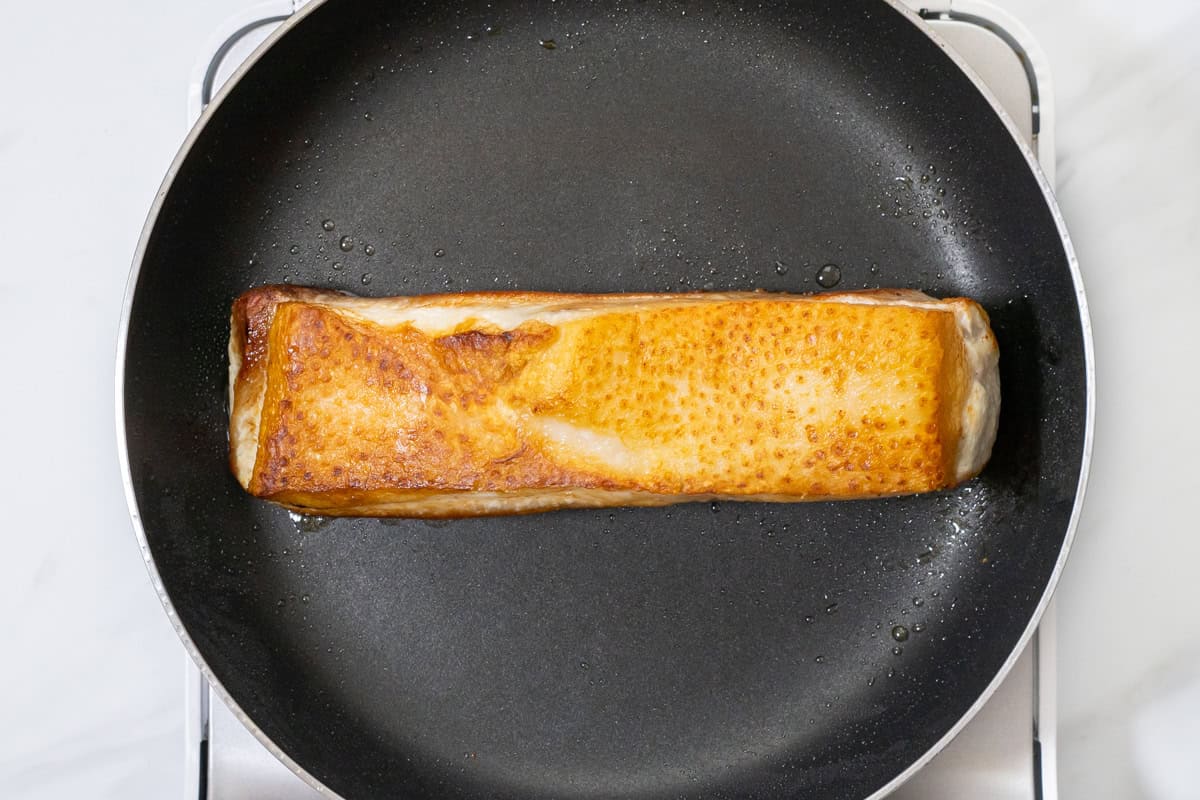
Simmer the pork
This step tenderizes the meat and removes any unpleasant odors. Instead of simply simmering the pork in water, add ingredients such as fresh okara (soy pulp), ginger, garlic, uncooked rice, the green parts of naganegi (Japanese leek), or onion ends. These ingredients help neutralize the pork's odors. While the recipe uses ginger and the green parts of naganegi, feel free to substitute them with other ingredients.
The simmering time should be about 3 hours. While one hour is sufficient to tenderize the meat, longer simmering makes the meat much more tender, renders excess fat, and enhances the flavor of the dish.
At this point, it is important to note that the pork may float while simmering, which could cause the exposed surface to dry out. To address this, in Japan, it is common to use an otoshi-buta, which is a drop lid placed directly on top of the ingredients. In the recipe, a paper towel is used as an otoshi-buta. Place it over the pork while simmering to prevent the surface from drying out and to ensure even cooking.
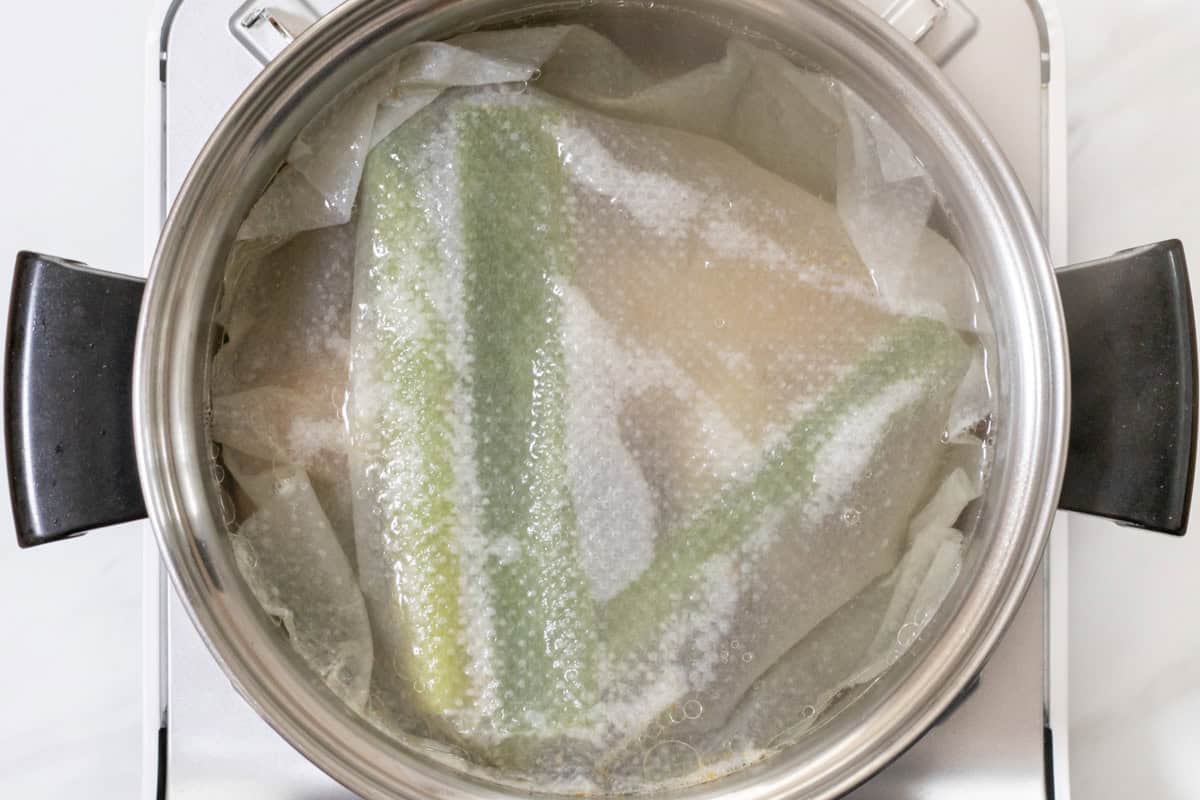
Cut the pork
Once the pork has finished simmering, let it cool before cutting it. This is the best time to cut the pork. If you cut it before simmering, the pieces may fall apart during cooking, and cutting it while it is still warm poses a similar risk.
One of the joys of this dish is eating it in cube-shaped pieces and enjoying its texture as it breaks apart in your mouth. To achieve this, be sure to let the meat cool before slicing.
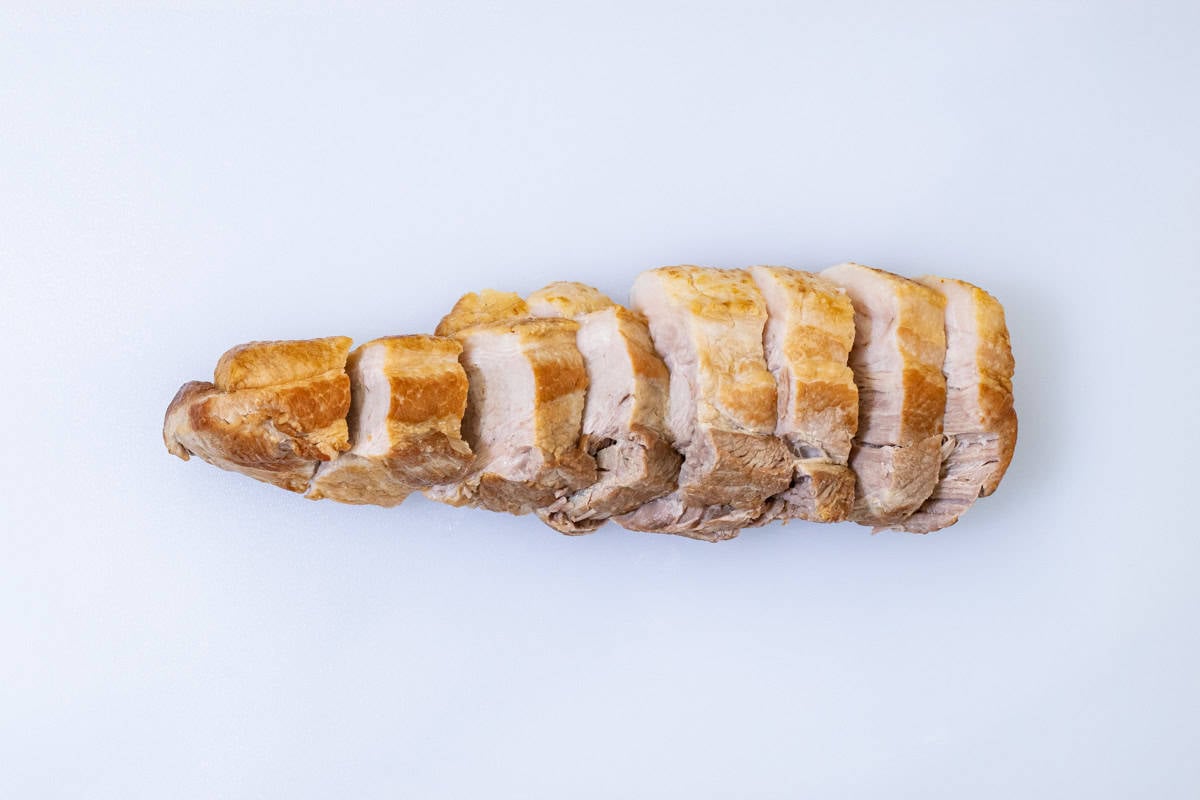
Season the pork
After cutting the pork, it is time to simmer it in a seasoned liquid. The recipe calls for sake, sugar, and soy sauce, but these ingredients should be added in stages. Start by adding the sake, followed by the sugar, and finally the soy sauce.
Adding sake first helps the flavors penetrate the meat more easily. Then, adding sugar and soy sauce in that order is important because the salt content in soy sauce can hinder the absorption of sweetness from sugar. This is due to the fact that the salt molecules in soy sauce are larger than those of sugar.
This stepwise addition of seasonings is a fundamental technique in Japanese cooking worth remembering. It can also be used when preparing other Japanese simmered dishes.
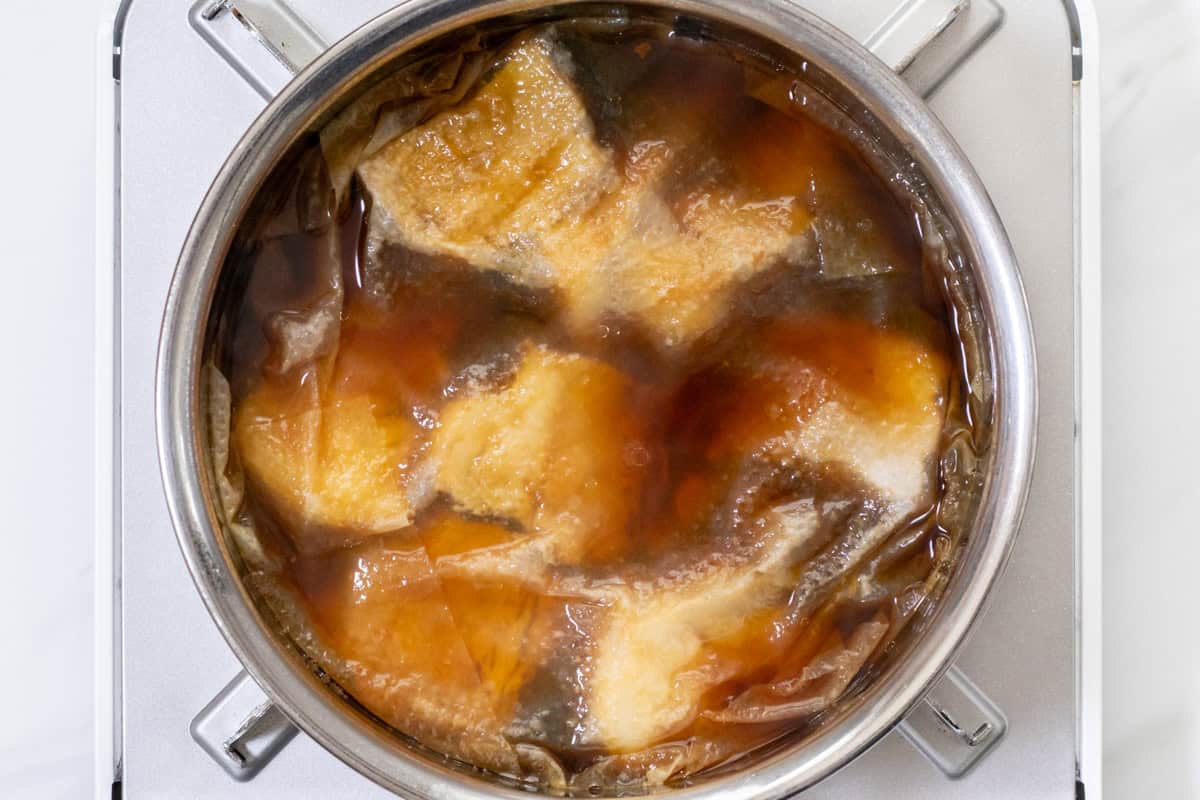
Infuse the pork with flavor
After simmering the pork in the seasoned liquid, let it cool and thoroughly soak up the flavors. The ingredients release their moisture during simmering and absorb moisture as they cool. The process of returning moisture allows the cooking liquid to be absorbed into the ingredients, helping the flavors penetrate deeply.
The resting time should ideally be overnight (8-10 hours) or longer. While this step takes time, it is essential for achieving the best result. This resting process is also a traditional technique in Japanese cooking that can be applied to other simmered dishes. It is a highly effective way to enhance the dish's flavor.
Once the pork has rested, reheat it along with the cooking liquid. Then, your buta no kakuni is ready to serve.
Optional additions
By following the steps above, you can make this dish truly delicious. However, there are some popular additions in Japan that can enhance the dish: boiled eggs and shiraga negi (shredded Japanese leeks). These ingredients pair wonderfully with the dish's rich flavor and add vibrant color. While optional, if you would like to include them, follow the additional steps below:
Boiled eggs: Bring a pot of water to a boil and gently lower the eggs in. You can cook them to your preferred level of doneness, whether soft-boiled or hard-boiled. For soft-boiled eggs, boil the eggs for about 7 minutes, then transfer them to a bowl of cold water to stop the cooking process.
Once cooled, peel the eggs and add them to the pot with the pork during the infusion process. This allows the eggs to soak up the flavorful liquid.
Shiraga negi (shredded Japanese leeks): Cut a 2-inch (5 cm) piece of naganegi (regular leeks can be substituted) in half lengthwise. Remove the pale green inner parts and thinly slice the white sections into long, narrow strips.
Soak the sliced naganegi in water to mellow its sharp flavor, then drain and pat it dry. Once your buta no kakuni is ready, garnish it with the shredded naganegi on top.

📋Step-by-step recipe
Ingredients
- 1 ⅓ lb pork belly
- 0.4 oz ginger
- 1 oz green part of Japanese leek (naganegi) (can be substituted with regular leek)
- 2 inches white part of Japanese leek (naganegi) (optional)
- 3 boiled eggs (optional)
For the seasoning:
- 2 cups water (for step 7)
- ⅖ cup sake
- 1.8 oz sugar
- ⅓ cup soy sauce
Instructions
🕒 Total: 12 hrs 40 mins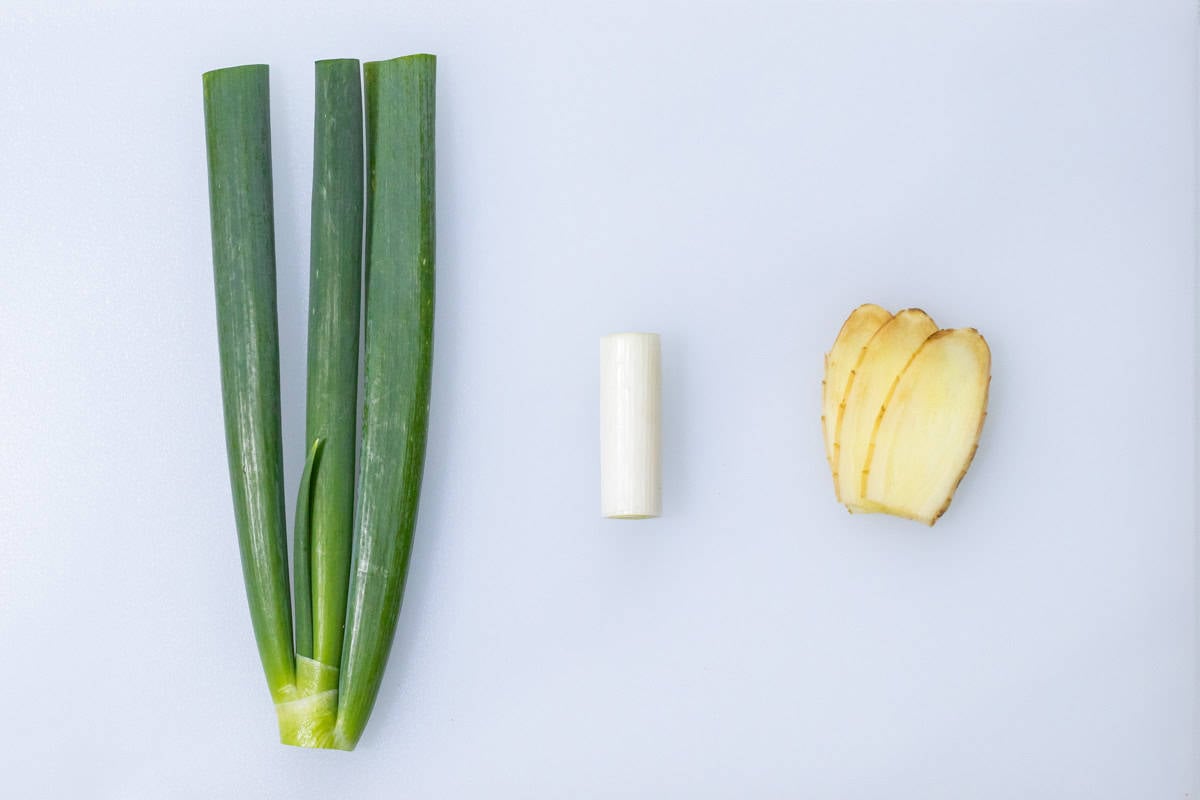
Step 1
Separate the green and white parts of the Japanese leek (using about 2 inches / 5 cm of the white part). Slice the ginger without peeling the skin. If the pork belly you are using is too large to fit comfortably in your pan or pot, cut it into large chunks.

Step 2
Heat a pan over medium heat. Once the pan is hot, place the pork fat-side down and sear it for 5 minutes until it turns golden brown. Sear the remaining three sides for 1 minute each to brown them. Be sure to wipe off any rendered fat with paper towels while cooking.
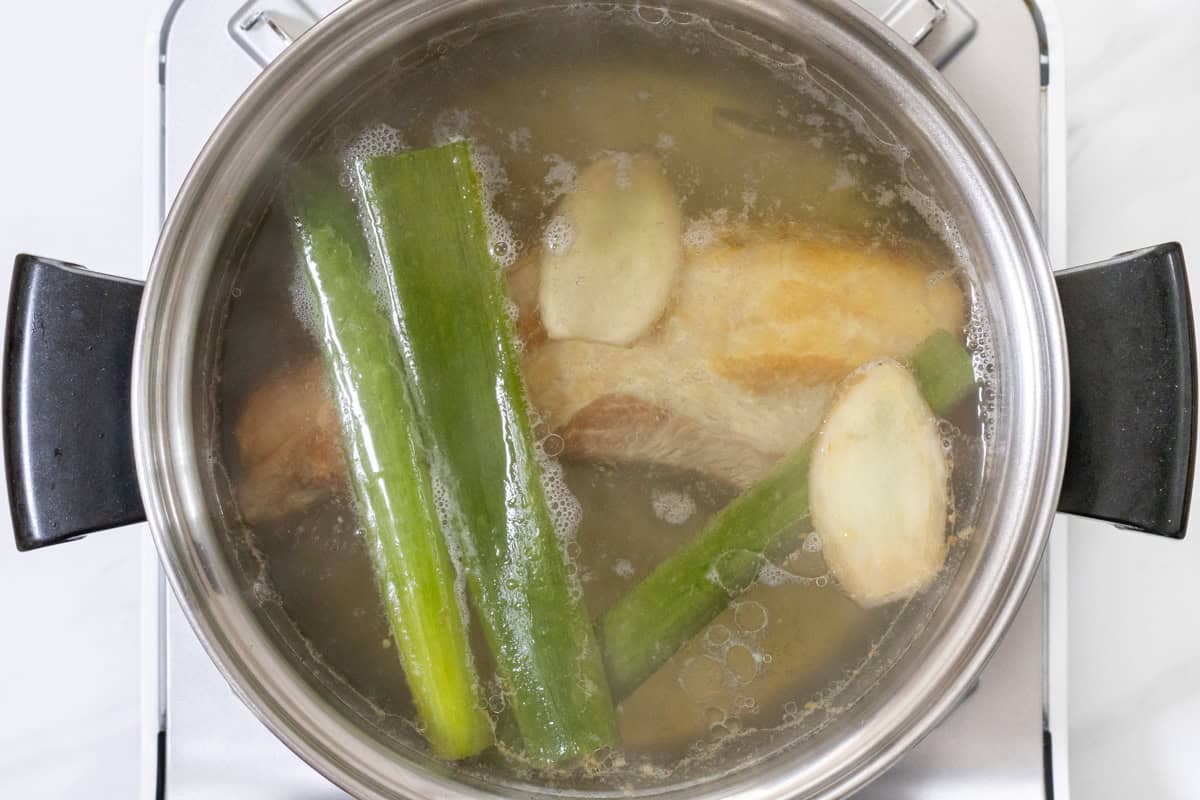
Step 3
Transfer the pork to a large pot and add the green parts of the Japanese leek, sliced ginger, and enough water to fully submerge the pork. Then, bring it to a boil.

Step 4
Once the water comes to a boil, reduce the heat to very low, keeping it just at a gentle simmer. Cover the pork with a paper towel placed directly on top, and let it simmer for about 3 hours. If the water level decreases enough to expose the pork, be sure to add boiling water to keep it submerged as needed.
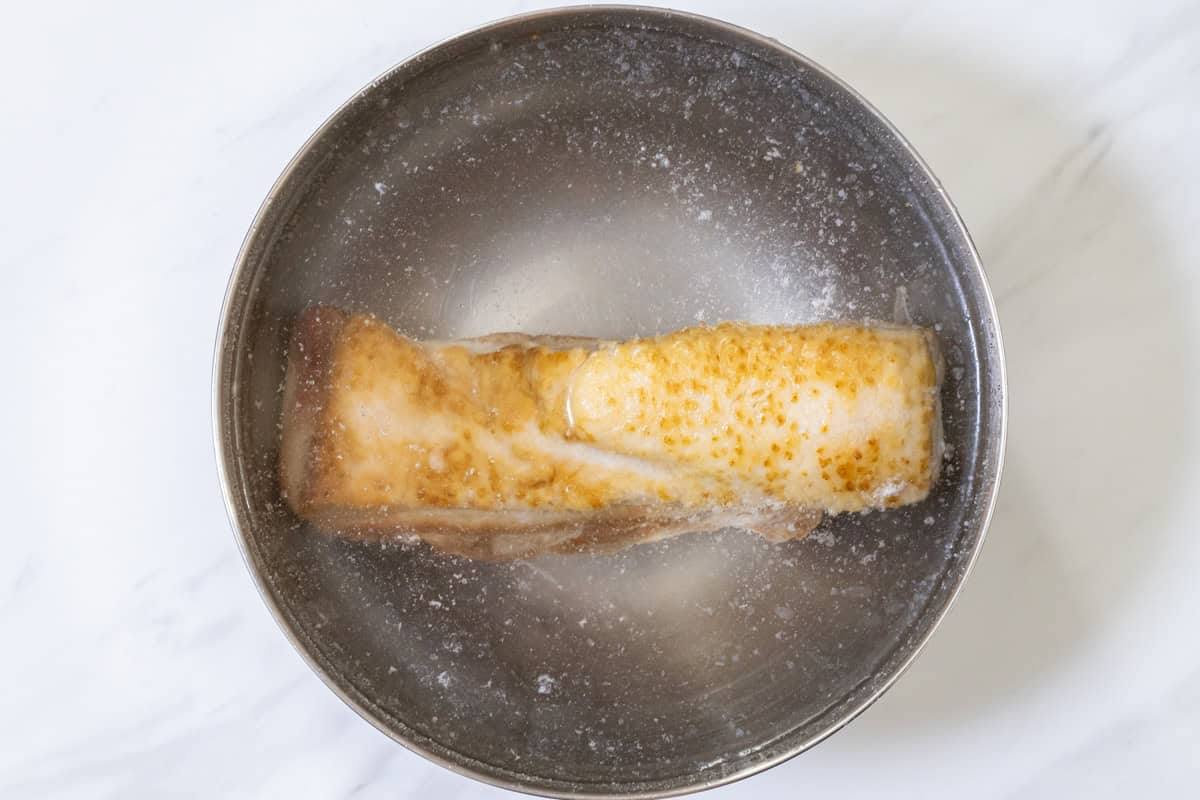
Step 5
Remove the pork from the pot and rinse it lightly under running water. Soak it in a bowl of cold water for about 5 minutes, changing the water as needed to cool it completely.
As for the cooking liquid in the pot, discard it because it won’t be used in this recipe. If you want to reuse it, wait for the fat in the liquid to solidify, remove it, and then use the remaining liquid as broth for soup. You will need a large pot again in later steps, so if you plan to reuse this one, make sure to wash it now.

Step 6
Cut the pork into pieces slightly larger than bite-sized, about 1-1.6 inches (2.5-4 cm) wide.
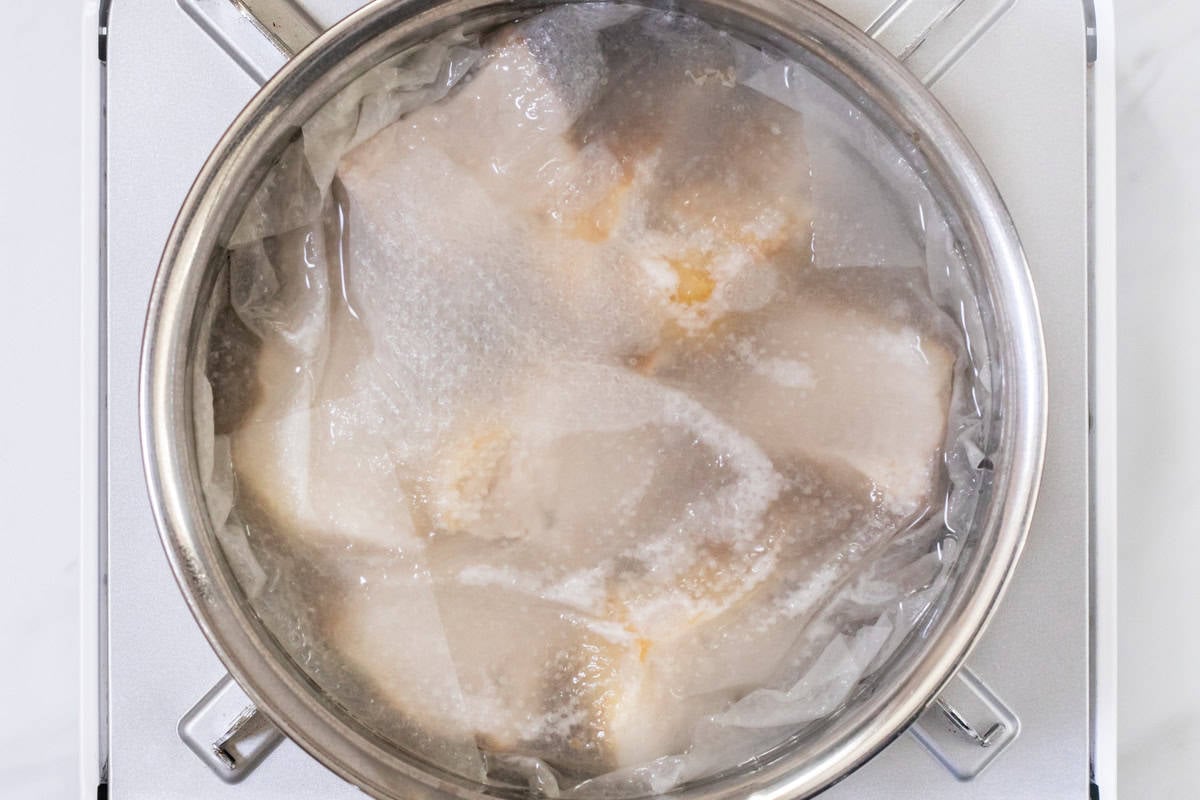
Step 7
Add water (as specified in the recipe), sake, and pork to a large pot, and bring it to a boil. Once boiling, skim off any scum from the surface. Reduce the heat to very low, just enough to keep it barely simmering, and add sugar. Once the sugar has dissolved, place a paper towel directly over the pork and let the pot simmer for about 10 minutes.

Step 8
Pour soy sauce over the paper towel, then bring the pot back to a boil over medium heat. Once it starts boiling again, reduce the heat to very low and let it simmer for 1 hour. After simmering, remove the pot from the heat and let it rest overnight (about 8 hours or more) to allow the flavors to soak into the pork. Make sure to transfer the pot to the refrigerator, covered with a lid, once it has cooled to room temperature.
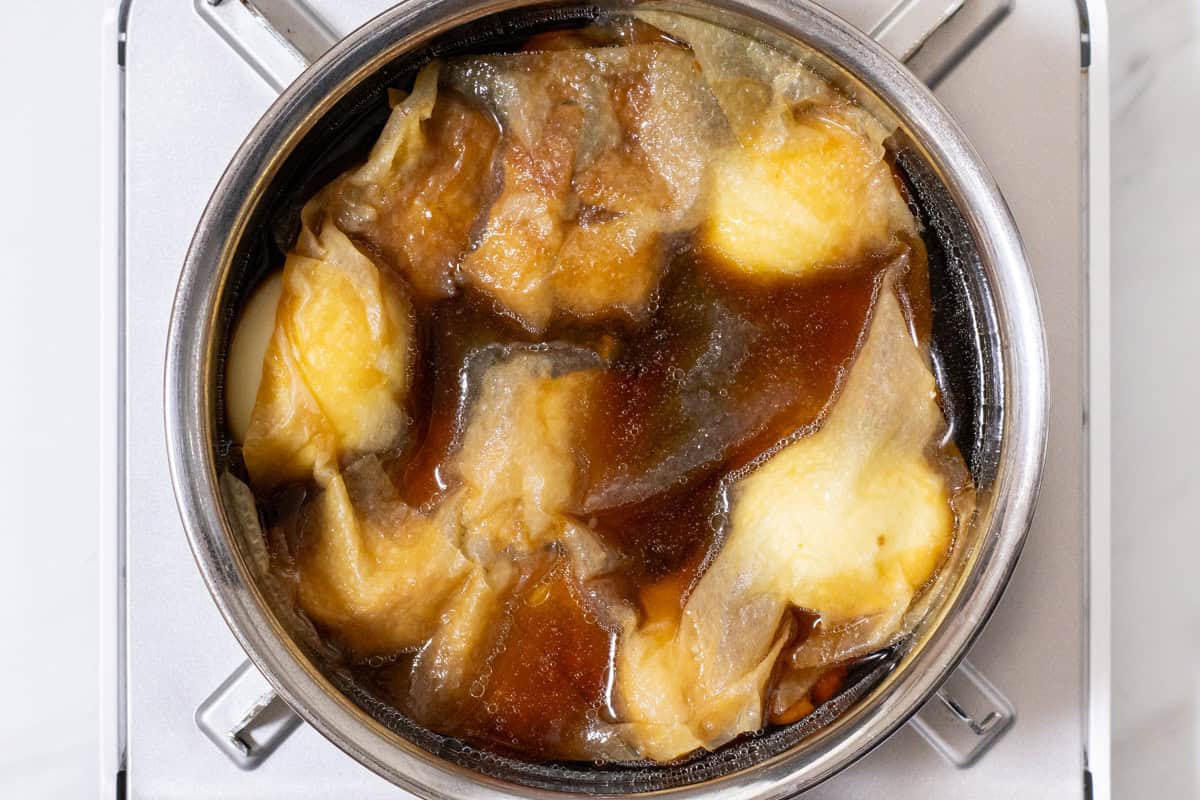
Step 9 (optional)
(When adding boiled eggs) Peel boiled eggs and place them under the paper towel in the pot, allowing them to soak up the flavors along with the pork. If you are using soft-boiled eggs, be sure to add them only after the pot has cooled to room temperature.
For instructions on how to make soft-boiled eggs, refer to the "Optional Additions" section above.

Step 10
Remove as much solidified fat as possible from the surface of the liquid in the pot. Bring the liquid to a brief boil, then turn off the heat. If any part of the pork is sticking out of the liquid, flip it over to ensure even heating. It is now ready to serve.
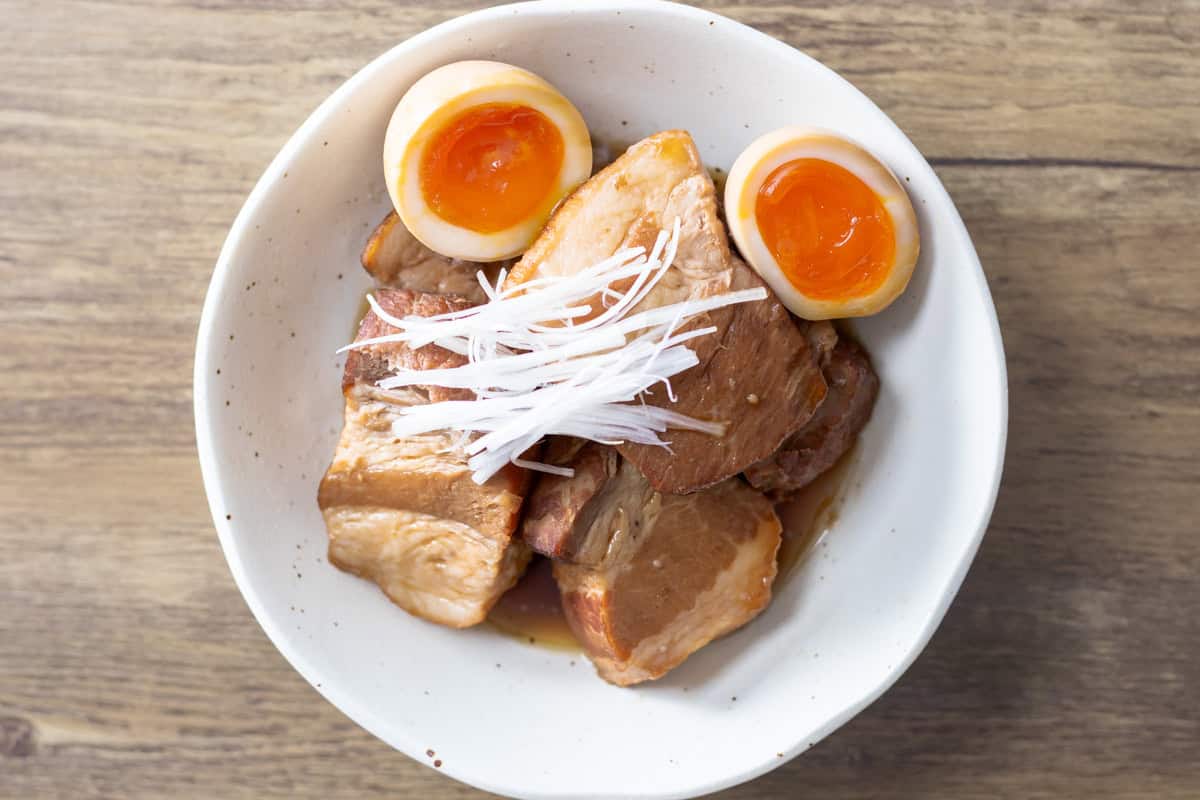
Step 11 (optional)
(When adding shredded Japanese leeks) Remove the inner pale green parts of Japanese leek, then thinly slice the white sections into long, narrow strips. Soak the sliced leeks in water to mellow their sharp flavor, then drain and pat them dry. Once your buta no kakuni is ready, garnish it with the shredded leeks.
To store
You can store it in the refrigerator for up to 4 days.
How to use the leftover cooking liquid
You can simply discard the leftover cooking liquid after making this dish. However, if you add boiled eggs and let them soak up the flavors, you will have flavorful seasoned eggs to enjoy again.
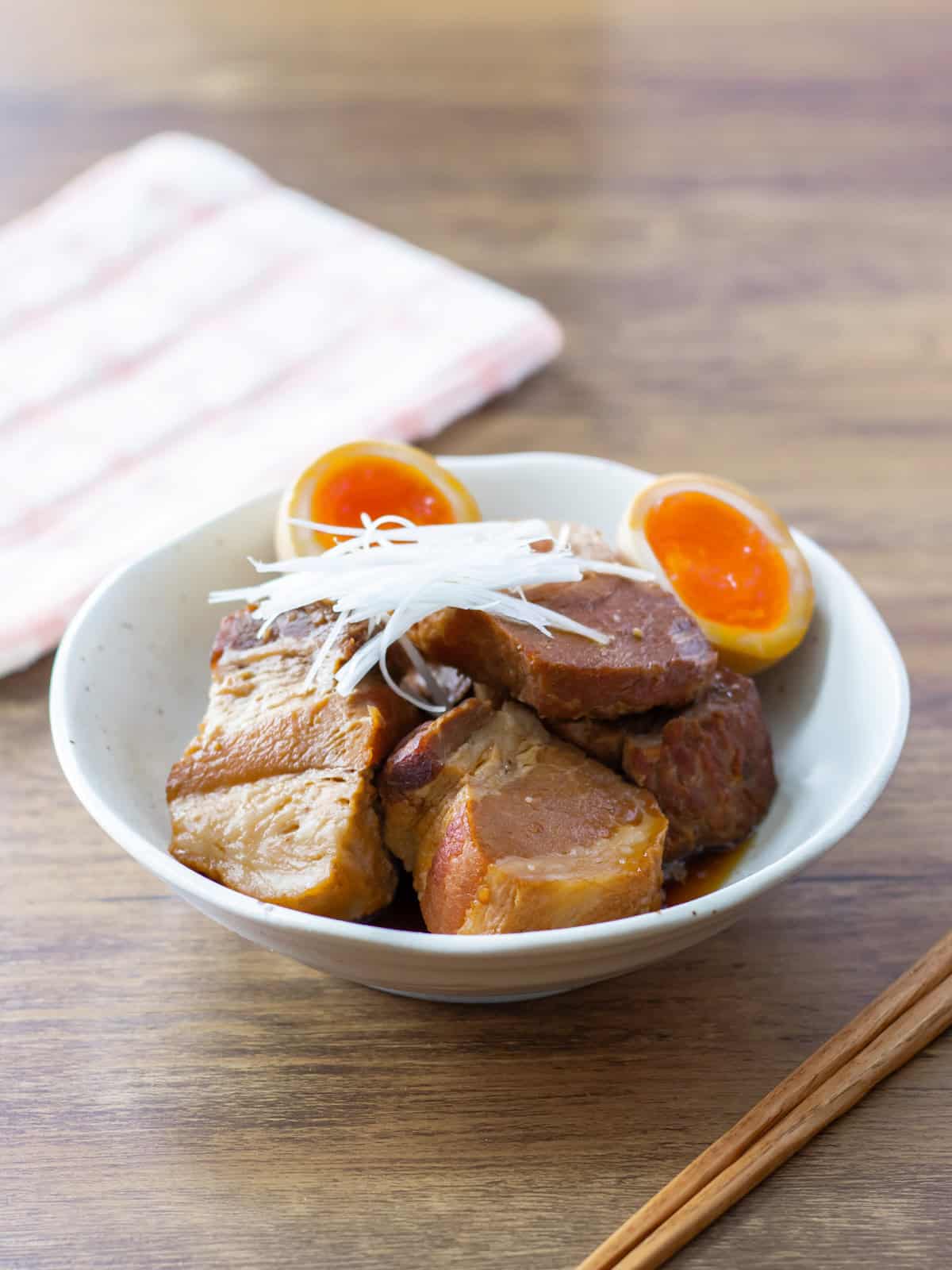
If you try this recipe, I’d love to hear what you think. Please consider leaving a review and star rating in the comments below. If you enjoyed it, I’d really appreciate it if you shared it with your friends.
More pork recipes you'll love
Recipe card

Buta no Kakuni (Japanese Simmered Pork Belly)
Ingredients
- 1 ⅓ lb pork belly
- 0.4 oz ginger
- 1 oz green part of Japanese leek (naganegi) (can be substituted with regular leek)
- 2 inches white part of Japanese leek (naganegi) (optional)
- 3 boiled eggs (optional)
For the seasoning:
- 2 cups water (for step 7)
- ⅖ cup sake
- 1.8 oz sugar
- ⅓ cup soy sauce
Instructions
- Separate the green and white parts of the Japanese leek (using about 2 inches / 5 cm of the white part). Slice the ginger without peeling the skin. If the pork belly you are using is too large to fit comfortably in your pan or pot, cut it into large chunks.
- Heat a pan over medium heat. Once the pan is hot, place the pork fat-side down and sear it for 5 minutes until it turns golden brown. Sear the remaining three sides for 1 minute each to brown them. Be sure to wipe off any rendered fat with paper towels while cooking.
- Transfer the pork to a large pot and add the green parts of the Japanese leek, sliced ginger, and enough water to fully submerge the pork. Then, bring it to a boil.
- Once the water comes to a boil, reduce the heat to very low, keeping it just at a gentle simmer. Cover the pork with a paper towel placed directly on top, and let it simmer for about 3 hours. If the water level decreases enough to expose the pork, be sure to add boiling water to keep it submerged as needed.
- Remove the pork from the pot and rinse it lightly under running water. Soak it in a bowl of cold water for about 5 minutes, changing the water as needed to cool it completely.As for the cooking liquid in the pot, discard it because it won’t be used in this recipe. If you want to reuse it, wait for the fat in the liquid to solidify, remove it, and then use the remaining liquid as broth for soup. You will need a large pot again in later steps, so if you plan to reuse this one, make sure to wash it now.
- Cut the pork into pieces slightly larger than bite-sized, about 1-1.6 inches (2.5-4 cm) wide.
- Add water (as specified in the recipe), sake, and pork to a large pot, and bring it to a boil. Once boiling, skim off any scum from the surface. Reduce the heat to very low, just enough to keep it barely simmering, and add sugar. Once the sugar has dissolved, place a paper towel directly over the pork and let the pot simmer for about 10 minutes.
- Pour soy sauce over the paper towel, then bring the pot back to a boil over medium heat. Once it starts boiling again, reduce the heat to very low and let it simmer for 1 hour. After simmering, remove the pot from the heat and let it rest overnight (about 8 hours or more) to allow the flavors to soak into the pork. Make sure to transfer the pot to the refrigerator, covered with a lid, once it has cooled to room temperature.
- (When adding boiled eggs) Peel boiled eggs and place them under the paper towel in the pot, allowing them to soak up the flavors along with the pork. If you are using soft-boiled eggs, be sure to add them only after the pot has cooled to room temperature.For instructions on how to make soft-boiled eggs, refer to the "Optional Additions" section above.
- Remove as much solidified fat as possible from the surface of the liquid in the pot. Bring the liquid to a brief boil, then turn off the heat. If any part of the pork is sticking out of the liquid, flip it over to ensure even heating. It is now ready to serve.
- (When adding shredded Japanese leeks) Remove the inner pale green parts of Japanese leek, then thinly slice the white sections into long, narrow strips. Soak the sliced leeks in water to mellow their sharp flavor, then drain and pat them dry. Once your buta no kakuni is ready, garnish it with the shredded leeks.
Notes
- You can store it in the refrigerator for up to 4 days.
- You can simply discard the leftover cooking liquid after making this dish. However, if you add boiled eggs and let them soak up the flavors, you will have flavorful seasoned eggs to enjoy again.
- The listed nutritional values are estimates based on the assumption that all of the seasoned cooking liquid is consumed.

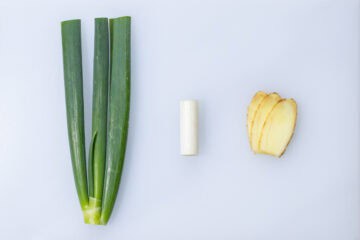

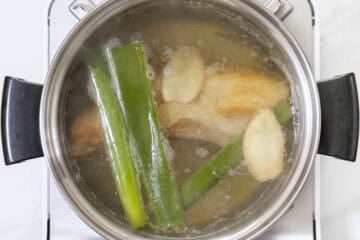
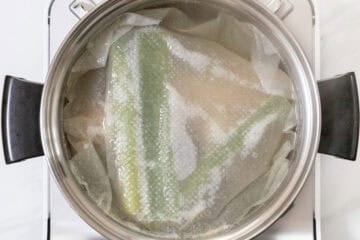
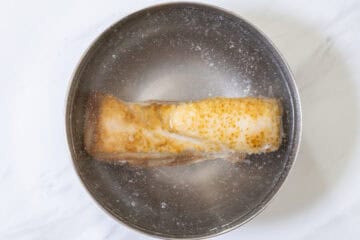
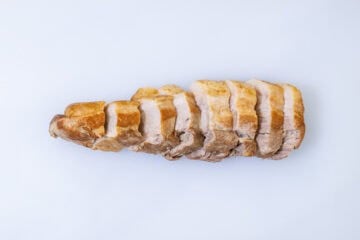
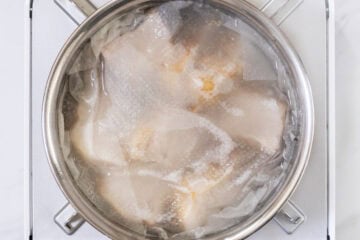
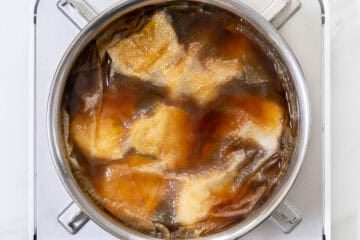
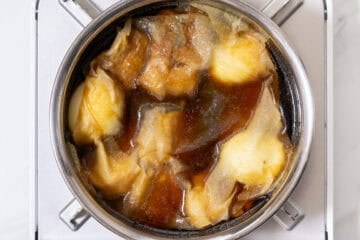
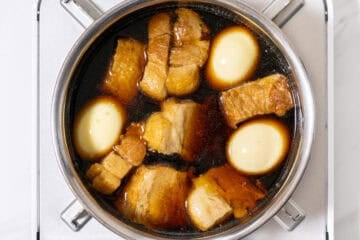
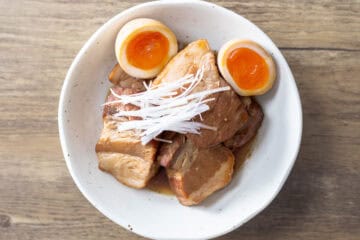




Leave a Rating and a Comment